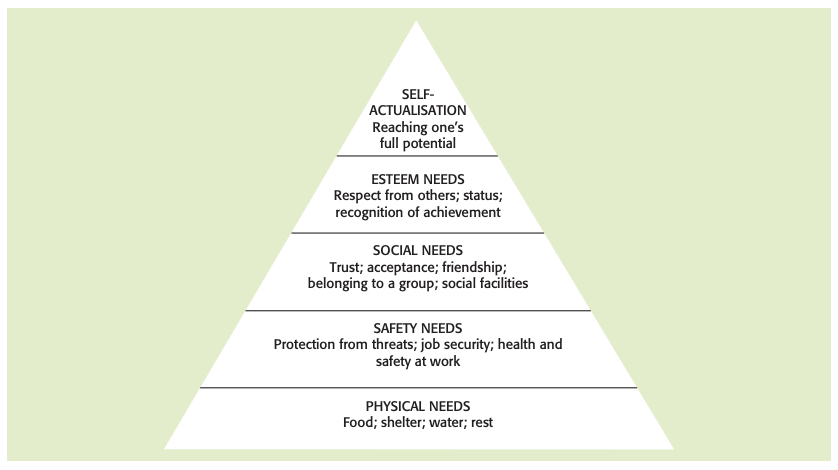2.4 Motivation
Introduction
Motivation: intrinsic and extrinsic factors that stimulate people to take actions that lead to achieving a goal.
Extrinsic motivation comes from external rewards associated with working on a task, for example pay and other benefits.
Intrinsic motivation comes from the satisfaction derived from working on and completing a task.
Motivation theories
F. W. Taylor and scientific management
- It uses scientific methods to analyze the most efficient production process in order to increase productivity.
- Economic man
- Select the right people for each job
- Observe and record the performance of staff
- Establish the best method of doing a
job method study - Piece-rate payment systems - to maximize output through motivating workers to produce more
Maslow’s hierarchy of human needs
- Our needs determine our actions we will always try to satisfy them and we will be motivated to do so. If work can be organized so that we can satisfy some or all of our needs at work, then we will become more productive and satisfied.

Herzberg and the “two-factor theory”
- He considered that the hygiene factors had to be addressed by management to prevent dissatisfaction, but even if they were in place, they would not, by themselves, create a well-motivated workforce.
- Motivating factors (motivators): aspects of a worker’s job that can lead to positive job satisfaction, such as achievement, recognition, meaningful and interesting work and advancement at work.
- Hygiene factors: aspects of a worker’s job that have the potential to cause dissatisfaction, such as pay, working conditions, status and over-supervision by managers.
Adams and equity theory
- Employees become demotivated towards their jobs and employer if they feel that their inputs are greater than their outputs.
- Inputs include effort, loyalty, commitment and skill.
- Outputs include financial rewards, recognition, security and sense of achievement.
- While many of these factors cannot be quantified, Adams argued that employers should attempt to achieve a fair balance between what the employee gives an organization and what they receive in return.
- If workers consider that their inputs are greater than the outputs received, they will move to try to redress this imbalance.
- When a balance is reached, then employees will consider their treatment to be fair and will respond with positive attitudes and high levels of motivation.
Motivation in practice
Payment or financial reward systems
- Salary: annual income that is usually paid on a monthly basis.
- The salary level is fixed each year and it’s not dependent on the number of hours worked or the number of units produced. The fixing of the salary level for each job is a very important process because it helps determine the status of that post in the whole organization.
- Hourly wage rate: payment to a worker made for each hour worked
- Piece rate: payment to a worker for each unit produced
- Commission: payment to a sales person for each sale made
- Performance-related pay: bonus scheme to reward staff for above-average work performance
- Profit-related pay (PRP): bonus for staff based on the profits of the business usually paid as a proportion of basic salary
- Employee share-ownership schemes
- Some profit-sharing schemes do not offer cash, but shares in the business to each worker when the firm declares a profit.
- Fringe benefits (perks): non-cash forms of reward - and there are many alternatives that can be used. They include company cars, free insurance and pension schemes, private health insurance, discounts on company products and low-interest rate loans. They are used by businesses in addition to normal payment systems in order to give status to higher-level employees and to recruit and retain the best staff.
Non-financial methods of motivation
- Job enlargement: attempting to increase the scope of a job by broadening or deepening the tasks undertaken.
- Job enrichment: attempting to motivate employees by giving them opportunities to use the full range of their abilities.
- Job redesign involves the restructuring of a job usually with employees’ involvement and agreement to make work more interesting, satisfying and challenging.
- Job rotation: practice of moving employees between different tasks to promote experience and variety.
- Team working: production is organized so that groups of workers undertake complete units of work.